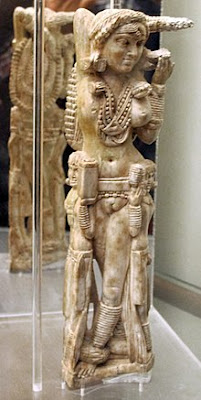Pompeii Lakshmi is an ivory statuette of Lakshmi was unearthed amidst the remains of Pompeii, a Roman city devastated by the eruption of Mount Vesuvius in 79 CE. This remarkable artifact was discovered in 1938 by Amedeo Maiuri, a distinguished Italian scholar.
Pompeii Lakshmi in Secret Museum of Naples
The Lakshmi statuette of Pompeii has been accurately dated back to the first century CE. This exquisite sculpture is believed to depict an Indian goddess symbolizing feminine beauty and fertility. Interestingly, it is speculated that the statuette might have initially served as a handle for a mirror. The presence of the yakshi provides compelling evidence of the thriving commercial exchange between India and Rome during this period.
Initially, it was believed that the figurine symbolized the Hindu Goddess Lakshmi, an esteemed goddess of prosperity, attractiveness, and abundance venerated by early adherents of Hinduism, Buddhism, and Jainism. Nevertheless, the symbolism, notably the visible reproductive organs, suggests that the sculpture is more inclined to portray a yakshi, a feminine spirit associated with fertility, or conceivably a fusion of Venus-Sri-Lakshmi from an ancient amalgamation of Classical Greco-Roman and Indian civilizations.
Secret Museum of Naples
Pompeii Lakshmi figure is now exhibited in the Secret Museum in the National Archaeological Museum, Naples, Italy.
The Secret Museum or Secret Cabinet (Italian: Gabinetto Segreto) in National Archaeological Museum in Naples houses a remarkable collection of Roman erotic art from the 1st century. These captivating artworks were discovered in Pompeii and Herculaneum and are now displayed in separate galleries within the museum, which was previously known as the Museo Borbonico.
Attributes
Material - Ivory
Height - 24.5 cm (9+1⁄2 in)
Discovered - c. 1930–1938 Pompeii
Present location - Secret Museum, Naples, Italy
Identification - 149425

Comments
Post a Comment